Unlike the ideal op-amp (Fig. 5-1), the op-amp that
is used in more realistic circuits today, does not have infinite gain and
bandwidth. Look at Open-loop gain in Fig. 4 above, it is graphed for a type 741
op-amp as a function of frequency. At very low frequencies, the open-loop gain
of an op-amp is constant, but starts to taper off at about 6Hz or so at a rate
of -6dB/octave or -20dB/decade (an octave is a doubling in frequency, and a
decade is a ten-fold increase in frequency). This decrease continues until
the gain is unity, or 0 dB. The frequency at which the gain is unity is called
the unity gain frequency or fT. Maybe the first factor in the consideration of a
specific op-amp is its "gain-bandwidth product" or GBP. For the
response curve of Fig. 4, the product of the open-loop gain and frequency is
a constant at any point on the curve, so that: GBP =
AolBW
Graphically, the bandwidth is the point at which the
closed-loop gain curve intersects the open-loop curve, as shown in Fig. 5 for a
family of closed-loop gains. For a more practical design situation, the actual
design of an op-amp circuit should be approximately 1/10 to 1/20 of the
open-loop gain at a given frequency. This ensures that the op-amp will function
properly without distortion. As an example, using the response in Fig. 4, the
closed-loop gain at 10Khz should be about 5 to 10, since the open-loop gain is
100 (40dB). One additional parameter is worth mentioning, the Transient
Response, or rise time is the time that it takes for the output signal
to go from 10% to 90% of its final value when a step-function pulse is used as
an input signal, and is specified under close-loop conditions. From electronic
circuit theory, the rise time is related to the bandwidth of the op-amp by the
relation: BW = 0.35 / rise
time
Open-Loop
Gain:
Lets have a look how the 'ideal' amplifier would look
like in Fig. 5-1. The search for an ideal amplifier is, of course, a futile
exercise. The characteristics of the operational amplifier are good enough,
however, to allow us to treat it as ideal. Below are some amplifier
properties that make this so. (Please realize that these ratings are next to
impossible to achieve).
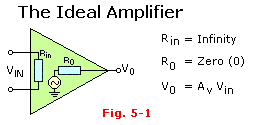
1. Gain--infinite
2. Input impedance--infinite
3. Output impedance--zero
4. Bandwidth--infinite
5. Voltage out--zero (when voltages into
each other are equal)
6. Current entering the amp at either
terminal--extremely smallThe "operation" referred to
mathematical operations, such as addition, integration, etc. An exact equivalent
of the ideal Op-Amp is called a "nullor" and it is composed of new elements --
the nullator and the norator. The input to the op-amp is the
nullator (i.e. no voltage or current), while the output is the norator (i.e. any
voltage or current). These two components give the device its ideal
characteristics.
Power
Supply:
In general op-amps are designed to be powered from a
dual or bipolar voltage supply which is typically in the range of +5V to +15Vdc
with respect to ground, and another supply voltage of -5V to -15Vdc with
respect to ground, as shown in Fig. 7. Although in certain cases an op-amp, like
the LM3900 and called a 'Norton Op-Amp', may be powered from a single supply
voltage.
Electrical
Ratings:
Electrical characteristics for op-amps are usually
specified for a certain (given) supply voltage and ambient temperature. Also,
other factors may play an important role such as certain load and/or source
resistance. In general, all parameters have a typical minimum/maximum value in
most cases.
 Fig. 6 - The two most common
types are shown in the diagram on the right. Depending on the application, the
8-pin version is used the most, worldwide. Actually, there is a third type in
the form of a metal-can but is obsolete and, by my knowledge, no longer used. I
have two of these metal-can types and keep them as a 'gone-by'
memory.
Fig. 6 - The two most common
types are shown in the diagram on the right. Depending on the application, the
8-pin version is used the most, worldwide. Actually, there is a third type in
the form of a metal-can but is obsolete and, by my knowledge, no longer used. I
have two of these metal-can types and keep them as a 'gone-by'
memory.
Definition of 741-pin
functions: (Refer to the internal 741 schematic of Fig.
3)
Pin 1 (Offset
Null): Offset nulling, see Fig. 11. Since the op-amp is
the differential type, input offset voltage must be controlled so as to minimize
offset. Offset voltage is nulled by application of a voltage of opposite
polarity to the offset. An offset null-adjustment potentiometer may be used to
compensate for offset voltage. The null-offset potentiometer also compensates
for irregularities in the operational amplifier manufacturing process which may
cause an offset. Consequently, the null potentiometer is recommended for
critical applications. See 'Offset Null Adjustment' for method.
Pin 2 (Inverted Input): All input
signals at this pin will be inverted at output pin 6. Pins 2 and 3 are very
important (obviously) to get the correct input signals or the op amp can not do
its work.
Pin 3 (Non-Inverted
Input): All input signals at this pin will be processed
normally without inversion. The rest is the same as pin 2.
Pin 4 (-V): The V- pin (also
referred to as Vss) is the negative supply voltage terminal. Supply-voltage
operating range for the 741 is -4.5 volts (minimum) to -18 volts (max), and it
is specified for operation between -5 and -15 Vdc. The device will operate
essentially the same over this range of voltages without change in timing
period. Sensitivity of time interval to supply voltage change is low, typically
0.1% per volt. (Note: Do not confuse the -V with ground).
Pin 5 (Offset Null): See pin 1,
and Fig. 11.
Pin 6
(Output): Output signal's polarity will be the opposite
of the input's when this signal is applied to the op-amp's inverting input. For
example, a sine-wave at the inverting input will output a square-wave in the
case of an inverting comparator circuit.
Pin 7 (posV): The V+ pin (also referred to as
Vcc) is the positive supply voltage terminal of the 741 Op-Amp IC.
Supply-voltage operating range for the 741 is +4.5 volts (minimum) to +18 volts
(maximum), and it is specified for operation between +5 and +15 Vdc. The device
will operate essentially the same over this range of voltages without change in
timing period. Actually, the most significant operational difference is the
output drive capability, which increases for both current and voltage range as
the supply voltage is increased. Sensitivity of time interval to supply voltage
change is low, typically 0.1% per volt.
Pin
8 (N/C): The 'N/C' stands for 'Not Connected'. There is no
other explanation. There is nothing connected to this pin, it is just there to
make it a standard 8-pin package.
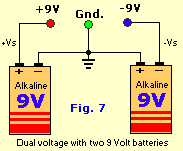 Experiments:
Experiments:
You are given the opportunity to
play with and analyze experiments to demonstrate the principles, concepts, and
applications of a couple of these basic configured op-amps.
If you have
already a dual-voltage power supply (positive/negative), that would make things
allot easier for you. If not, build this Dual Volt Powersupply listed at
the bottom of the page to get you started. This power supply has two
non-adjustable voltages; +12Vdc and -12Vdc. However, in general, a very simple
and cheap power supply can be rigged up with two 9 Volt alkaline batteries and
does the job in most, if not all, cases. Personally I like to approach a project
more professionally and build the dual 12 volt powersupply. Nice project
'in-between' while learning op-amps.
Bread Board
Modules:
A bread board module, or just 'breadboard', is a
board manufactured of plastic with a couple 100 tiny holes with tiny sockets in
them connected electrically together and in the center of the breadboard a grove
to hold a plastic panel for leds, pots and switches. They measure about 6 by 2
inches and come in white, gray and blue. The blue kind is called 'BimBoard' and
made in the UK. I purchased mine back in 1980 from ElectroSonic in Toronto Canada and its still
working fine. The gray and white models are manufactured in the U.S. and Canada.
They all work. Radio Shack and the European Tandy are both selling their own
version and they work fine too. The Bread Board Design System is also available,
if you can afford it, and would be preferred if you intend to do a lot more
experimenting in the future. This system contains everything you need already
build-in, like the powersupply, jacks, switches, leds, function generator and
lots more goodies. Kindah nice to have everything in one place.
The Norton Op-Amp:
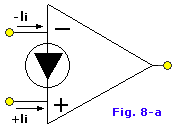
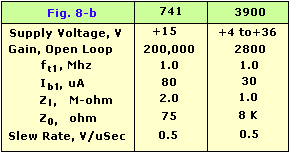 It is not my
intention to confuse you with a different type of op-amp so I will just mention
a couple points about this op-amp.
It is not my
intention to confuse you with a different type of op-amp so I will just mention
a couple points about this op-amp.
The Norton op-amp, or current-differencing
amplifier, is designed to operate from a single ended supply. Wow, that is truly
fantastic. You can use a voltage anywhere from +4V to a whopping +36V!
The
Norton op-amp referred to here is the LM3900 and is the best known type made by
National Semiconductor. This chip contains four op-amps in a single 14-pin
package. The picture in Fig. 8-a shows the symbol for the Norton op-amp. As you
may notice it is somewhat different than the normal op-amp symbol. Fig. 8-b
shows the major parameters of relevance between the LM741 and the LM3900
op-amps.
 The Peak Detector
The Peak Detector
The peak detector is a circuit that
"remembers" the peak value of a signal. As shown in Fig.
9-a, when a positive voltage is fed to the noninverting input
after the capacitor has been momentarily shorted (reset), the output voltage of
the op-amp forward biases the diode and charges up the capacitor. This charging
last until the inverting and noninverting inputs are at the same voltage, which
is equal to the input voltage. When the noninverting input voltage exceeds the
voltage at the inverting input, which is also the voltage across the capacitor,
the capacitor will charge up to the new peak value. Consequently, the capacitor
voltage will always be equal to the greatest positive voltage applied to the
noninverting input.
Once charged, the time that the peak detector
"remembers" this peak value is typically several minutes and depends on the
impedance of the load that is connected to the circuit. Consequently, the
capacitor will slowly discharge towards zero. To minimize this rate of
discharge, a voltage follower can be used to buffer the detector's output from
any external load, as shown in Fig. 9-b. Momentarily
shorting the capacitor to ground will immediately set the output to
zero.
 The Comparator
The Comparator
A 'comparator' is circuit that compares
an input voltage with a reference voltage. The output of the comparator then
indicates whether the input signal is either above or below the reference
voltage. As shown for the basic circuit in Fig. 9-c(1) ,
the output voltage approaches the positive supply voltage when the input signal
is slightly greater than the reference voltage, Vref. When the input is slightly
less than the reference, the op-amp's output approaches the negative supply
voltage. Consequently, the exact threshold is dominated by the op-amp's input
offset voltage, which should be nulled out. Fig. 9-c(2)
shows a Led indicator which input is connected to the output Vout of the
comparator.
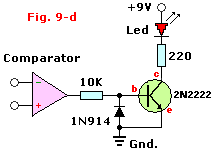
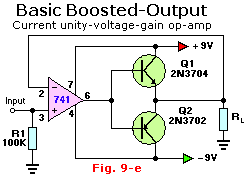
Fig. 9-d(left) The output polarity of the
op-amp switches from positive to negative, it is inconvenient to keep reversing
the voltmeter leads to keep polarity correct. One way to overcome that problem
is to use an indicator light to tell the output state. The circuit show on the
left uses a transistor to switch a led on or off depending on the comparator's
output state. When the op-amp output is 8.5 volts, the transistor switches on
the led via the 220 ohm current-limiting resistor. When the output is -8.5 volts
the transistor is cut-off turning off the led. Transistor choice is not
critical; it can be any common type NPN device. Any type of silicon diode will
protect the transistor. Fig. 9-e(right). The output on
pin 6 switches (repeatedly) from positive to negative and so either bias Q1
(NPN) or Q2 (PNP and activates RL which is
the resistive load. Just a basic circuit to show you what exactly a
'Boosted-Output' circuit does.
The Instrumentation
Amplifier
There are many types of op-amps who are designed for a
specific purpose like the Instrumentation Amplifier from Burr-Brown.(see Fig.
10) In this example we are talking about the 3660J type. It can be used in both
balanced and unbalanced systems, like a Wheatstone Bridge circuit. This does not
mean in any way that the instrumentation amp cannot be used for other
applications, on the contrary, it is in many a case preferred because of the
unique parameters of this device.
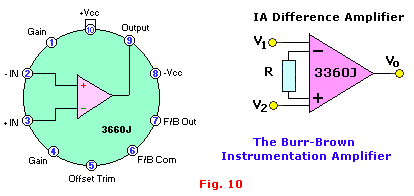
Keep this in mind as a rule-of-thumb:
An
operational amplifier circuit will not work at
all unless:
1. External feedback limits the
gain or desired response to a design value.
2. Both
inputs have direct-current return path to ground of a similar
reference.
3. The input frequencies and required gain
are well within the performance limitations of the op-amp
used.
Offset Null Adjustment Procedure for the
µA741:
Offset null adjustments differ with the application
(e.i. Inverting or Non-Inverting Amplifier). Offset-null potentiometers are
not placed on design schematics as they would detract from a design. For
practice, perform the following Offset Null adjustment if you
wish:
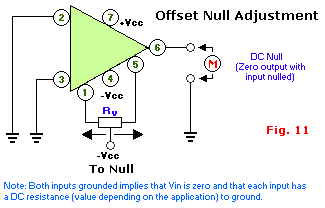 1. Adjust the 10K pot(entio)meter to its center position.
1. Adjust the 10K pot(entio)meter to its center position.
2.
Connect the potmeter outside leads between pins 1 and 5 of the op-amp.
Make
sure that the power is applied to the design application.
3. Connect
the wiper of the potmeter to the negative supply voltage.
4. Ensure
that input signals are zero or null and that pins 2 and 3 have a dc return to
ground.
5. Measure the output with a dc meter and obtain zero null by
adjusting the potentiometer.
This is just one method and recommended
nulling procedure for the µA741 type op-amp. Always look for, and follow the
particular procedure as specified by that chip manufacturer. Procedures may
become obsolete or updated and changed when improved op-amp versions come on the
market.
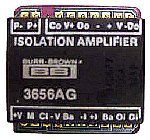 Burr-Brown:
Burr-Brown:
Look at this beauty at the right. It
is a 20-pin 3656AG Isolation Amplifier made by Burr-Brown. Just wanted to show
the chip because of its uniqueness. This gem measures about 22 x 28mm and is
part of my personal collection. The engineers of Burr-Brown have surely done a
marvelous job more than once.
Planning Your Prototype
or Experiment:
Planning the layout of your experiments could
be important, especially with large circuits. Use this [lay-out
sheet] to plan your components layout on the bread board, if you wish.
Remove every component and all wires from previous experiments.
Important: Before starting to insert components into
the breadboard, make sure all power and signal connections are removed and the
power source disconnected. And if required, take the glue/dirt of the
components' legs before inserting them into the sockets, it is very hard if not
impossible to get it cleaned out.
A couple circuit
examples:
Below are a couple circuit examples you can play and
experiment with to understand the working of a 741 op-amp hands on. If you are
serious about electronics I strongly recommend buying a book or two about
Op-Amps for your experimenting pleasures.
Fig. 12 - Light
Sensor
This is a really nice circuit to play with. When there is NO
light falling on the sensor, the relay closes. When light falls on the LDR, the
relay opens. To reverse the situation just exchange LDR and R1. Example uses for
this circuit: Dark-room, Automatic door-lock, closet, Shed Alarm,
etc.
Fig. 13 - Smart Continuity Tester
Occasionally you
need a continuity test between two points in an electronic circuit.
Unfortunately, most continuity testers are prone to "lie". They don't do that
deliberately, but if they see a small resistance, they still tell you
that you have continuity. They just don't know any better. This unit is
different. If you have continuity it will tell you so. And if you're reading
even a low resistance through a component, the unit will tell you that as well.
The unit uses two 741 op-amps. It offers a short-circuit test current of less
than 200uA. It detects resistance values of less than 10 ohms. Nicest of all, it
will not break down a PN junction. The device has come in handy in my own shop
for debugging electronic circuits.
Fig. 14 - 12V Battery
Monitor
The 100 Kilo-ohm trimmer pot controls the set point of this
circuit to a 'high' point like 12.5 or something, so adjust it to the point you
wish the LED to light up. To monitor a 'low' point, and have the led light up
when the battery has drained to a certain point, connect the led (via the 330
ohm resistor) to ground (in the blue-boxed area). The led is the high-brightness
or ultra-bright type for maximum visibility. The trimpot in the schematic is a
10-turn type for better accuracy, but basically any type will
do.
Fig. 15 - Low Power Amplifier
This is a simple low
power amplifier with a single powersupply. The Rx resistor + the resistance of
the speaker should equal 1000 ohm. Example: speaker is 150 ohm. Rx is 1000 - 150
= 850 ohm. Closest available value is 860 ohm. I know what your thinking; what
about the 30 volt? Isn't the max 15 volt? Yes, but positive and negative they
combine 30 volt.
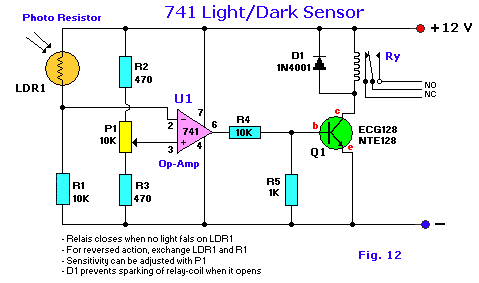
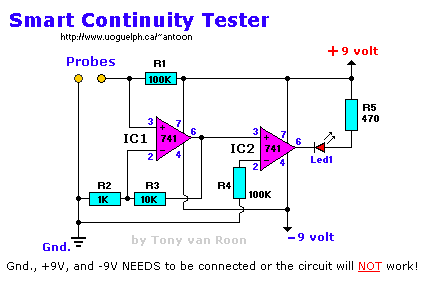
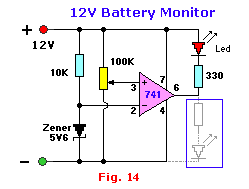

Below is the Dual Volt Power Supply to power the op-amps. Check the output
voltages when you are done. You may lower the 220µF caps to 100µF if need
be.
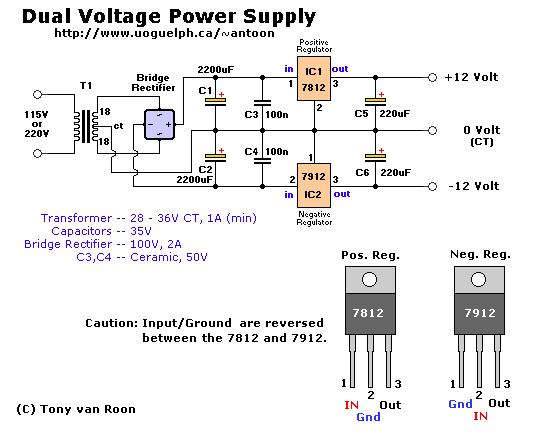
Suggested Reading:
"Active Filter Cookbook", by Don Lancaster, 1975, by Howard W.
Sams & CO., Publisher SAMS, ISBN: 0-672-21168-8
"CDA--The New Current
Differencing Amplifier", by W.G. Jung, June 1973, Popular Electronics, pp.
61-66.
"Design of OP-AMP Circuits With Experiments", H.M Berlin, 1987,
Howard W. Sams & Co., Inc. Publisher SAMS. ISBN: 0-672-21537-3
"IC
Op-Amp Cookbook", by W.G. Jung, 1974, by Howard W. Sams & CO., Publisher
SAMS.
"Introductory Experiments in Digital Electronics", by H.M.Berlin
(Book 1&2), Howard W. Sams & Co., Inc. Publisher SAMS.
"Logic
& Memory Experiments using TTL Integrated Circuits", by H.M.Berlin (Book
1&2), Howard W. Sams & Co., Inc. Publisher SAMS.
"Operational
Amplifiers--Design and Applications", by G.E.Tobey, J.G.Graeme, and
L.P.Huelsman, 1971. Publisher McGraw-Hill.
"The Design of Active Filters,
with Experiments", by H.M.Berlin, 1974. Howard W. Sams & Co., Inc.
Publisher SAMS.
"Understanding IC Operational Amplifiers", by R. Melen
and H. Garland, 1971. Reston Publishing Co., Publisher RESTON.
"The Art of
Electronics", by Horowitz and Hill, 1989, 2nd edition (3rd?), Cambridge
University Press, ISBN: 0-521-37095-7.
Copyright & Credits:
The following business
names, mentioned in this tutorial, are Trade Marked and protected under
International Copyright Law #660099:
ARRL - American Radio Relay League, ECG,
Fairchild Semiconductor, Howard W. Sams & CO. Publishing, McGraw-Hill
publishing, National Semiconductor, NTE, Philips, Raytheon Semiconductors, RCA,
Reston Publishing, Texas Instruments, Press Syndicate of the University of
Cambridge.
Some excerpts and graphics are used from SAMS Book "Design of
Op-Amp Circuits With Experiments" written by Howard M. Berlin. Re-print with
copyright permission obtained from: Pearson Education, Kiersti Kjonaas, Foreign
Rights. 201 West 103rd Street Indianapolis, IN 46200-1007 -- U.S.A. Tel (317)
581-3500
The beautiful picture of the tube op-amp is published here with
permission of Doug
Coward, owner of the "Analog
Computer Museum and History Center."
The text in 'The Ideal Op-Amp'
was modified to reflect a comment from Don Petzold in regards to the Nullator
and Norator. Good stuff Don, thanks very much!
Copyright © 2000 - Tony van Roon
(VA3AVR).
Last Updated on July 29,
2004


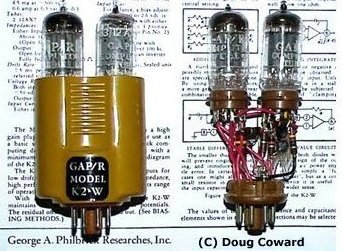 At the
left you see a picture of a K2-W tubes general purpose computing Op-Amp from
George A. Philbrick Researches. This type was first introduced in 1952, more
than a decade before the first transistorized version. The op-amp is shown with
and without its bakelite shell. What a beauty! The first solid-state monolithic
op-amp, designed by Bob Widlar, offered to the public in 1963 was the µA702
manufactured by Fairchild
Semiconductors but it had very weird supply voltages such as +12 and -6
volts and had a tendency to burn out when it was temporarily shorted. Despite
all these little shortcomings this device was the best in its day. It contained
just nine transistors and sold for about $300.00 US which limited the sales to
the Military and Aerospace consumers.
At the
left you see a picture of a K2-W tubes general purpose computing Op-Amp from
George A. Philbrick Researches. This type was first introduced in 1952, more
than a decade before the first transistorized version. The op-amp is shown with
and without its bakelite shell. What a beauty! The first solid-state monolithic
op-amp, designed by Bob Widlar, offered to the public in 1963 was the µA702
manufactured by Fairchild
Semiconductors but it had very weird supply voltages such as +12 and -6
volts and had a tendency to burn out when it was temporarily shorted. Despite
all these little shortcomings this device was the best in its day. It contained
just nine transistors and sold for about $300.00 US which limited the sales to
the Military and Aerospace consumers.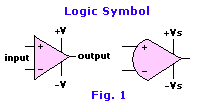
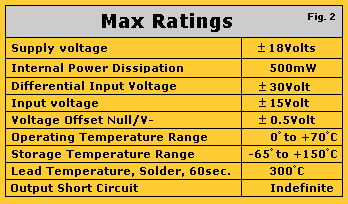 Supply Voltage (+/-Vs): The maximum voltage (positive
and negative) that can be safely used to feed the op-amp.
Supply Voltage (+/-Vs): The maximum voltage (positive
and negative) that can be safely used to feed the op-amp.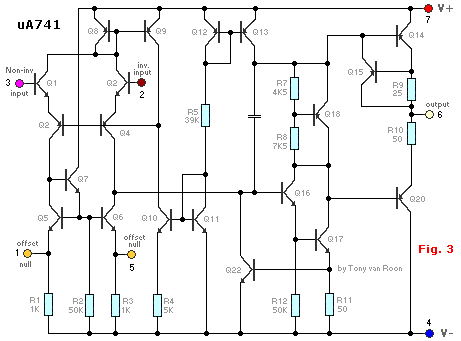
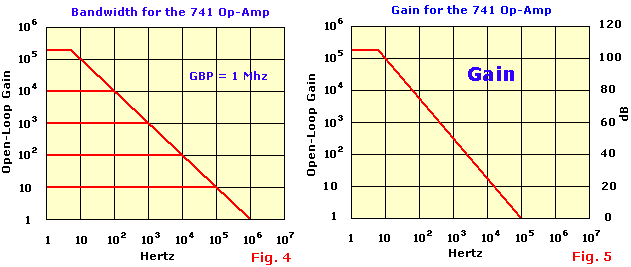

 Fig. 6 - The two most common
types are shown in the diagram on the right. Depending on the application, the
8-pin version is used the most, worldwide. Actually, there is a third type in
the form of a metal-can but is obsolete and, by my knowledge, no longer used. I
have two of these metal-can types and keep them as a 'gone-by'
memory.
Fig. 6 - The two most common
types are shown in the diagram on the right. Depending on the application, the
8-pin version is used the most, worldwide. Actually, there is a third type in
the form of a metal-can but is obsolete and, by my knowledge, no longer used. I
have two of these metal-can types and keep them as a 'gone-by'
memory. Experiments:
Experiments:
 It is not my
intention to confuse you with a different type of op-amp so I will just mention
a couple points about this op-amp.
It is not my
intention to confuse you with a different type of op-amp so I will just mention
a couple points about this op-amp. The Peak Detector
The Peak Detector The Comparator
The Comparator


 1. Adjust the 10K pot(entio)meter to its center position.
1. Adjust the 10K pot(entio)meter to its center position. Burr-Brown:
Burr-Brown: 



